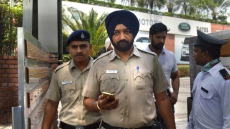Time changes everything. The hardcore face of Hindutva in the 1990s became the "acceptable" saffron leader in run up to 2014 elections and finally being sidelined in the party.
As the man who once went out on a nationwide rath yatra in demand for "bhavya Ram Mandir" celebrated his 92nd birthday, here's a look back at Lal Krishna Advani's political journey from a young leader to the face of Hindutva to a leader without a pack to lead on his 92nd birthday.
The Sindhi boy turned Jan Sangh chief:
A Sindhi by birth, he was enrolled in a Karachi College but had to shift to then Bombay during the Partition. But his association with Sangh was even before partition when he joined the Karachi wing of RSS in 1941, as an adolescent. As a pracharak, he worked in Rajasthan.
But soon his political instincts made him join the Bharatiya Jan Sangh, or commonly known as Jan Sangh when Syama Prasad Mookerjee founded it in 1951. But his first taste with the capital politics came in 1957, when he was asked to come to Delhi.
In the coming years, Advani rose in stature with speed. First he became the General Secretary followed by President of the Jan Sangh's Delhi unit. After the 1967 elections, he became the leader of the city's Metropolitan Council. By 1966, Advani became a name to reckon with and rose to the post of member of the national executive.
A Rajya Sabha member in 1970, Jan Sangh President in 1973, taking part in anti-Emergency fight against then Prime Minister Indira Gandhi and taking the Jan Sangh into the Janata Party - the 1970s saw the rise and rise of Advani.
The face of Ram Mandir movement:
After winning just 2 seats in the 1984 Lok Sabha elections, the Jan Sangh, now re-re-branded as today's BJP was looking to expand its footprint and remain a player in national politics in the next general election. In 1989, the BJP won 80 seats. But by 1990, the entire country was swept into an obsession for a grand Ram Mandir at the disputed site in Ayodhya where the Babri Masjid stood. Advani would be the face of the movement along with his party colleagues Murli Manohar Joshi and Uma Bharti.
Advani might have become a strong leader by then in his own right, but it was this movement that made him an inalienable part of India's polity and the rise of Hindutva. He began his Rath Yatra from Gujarat's Somnath and meant it to conclude in Ayodhya. The air-conditioned van made to look like a chariot, was meant to enthuse people so that they converge upon Babri Masjid in Ayodhya. Draped in saffron, often flashing a sword and donning tilak, Advani was no longer the President of the BJP that he was but the face of Hindutva politics, something India had not experienced since its Nehruvian socialist days.
Kar Sevaks converged in Ayodhya in October 1990 - though Advani was arrested in Bihar by Lalu Prasad's government, the mosque was stormed and bullets were fired resulting in deaths.
Though the mosque survived this onslaught, it was eventually brought down on December 6, 1992 under another mass campaign. This catapulted Advani into a position that was almost impossible to dethrone him from. He went on to become the Home Minister and even the Deputy Prime Minister of India when Atal Bihari Vajpayee returned to power in 1998 after the first foray in 1996 did not succeed, and again won in 1999.
The silent fall of the Hindutva icon:
But after the highs, the fall of Advani too was inevitable. After the BJP was voted out in 2004, it went to the 2009 Elections with Advani as its PM face, but the UPA sprung back to power. But by 2012, growing friction between Advani and the pro-Narendra Modi lobby started. Advani wanted to try his luck once more, assured of a BJP victory with UPA 2 ridden with corruption charges. But the nation's restless youth wanted a fresh face.
By 2013, the chorus for Modi, who was still the Chief Minister of Gujarat and a successful one, as NDA's PM candidate grew louder. The Goa convention of BJP marked the beginning of the end of Advani when BJP chose Modi as its campaign committee chief for 2014 general election. In Goa, during the BJP conclave, Modi roared: "We need the country free from Congress rule. Nation has never seen such brazenness and people are angry with Congress."
Reflecting the mood within the BJP ranks, then Goa Chief Minister Manohar Parrikar had said Modi should be the "face of the party" - a minimum six months before the general elections. Tacit backing came from Uma Bharti as well, someone who shared close proximity with Advani since her Ayodhya days.
First, Advani gave the national executive a miss and then wrote to Rajnath Singh, who was heading the BJP as President back then. Once Modi came to power, the divide created between the two due to Advani's strong opposition to Modi never healed. Though Advani was made part of the "Margdarshak Mandal", it became a running joke within BJP, in hushed tones. With the party constraining to play only public niceties, Adavani, by now more old and frail withdrew himself completely from active politics.
The fall of the one-time Hindutva icon was steep - and silent.


